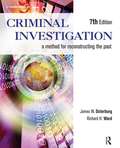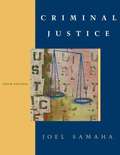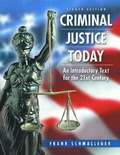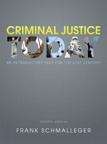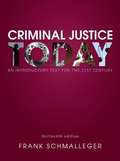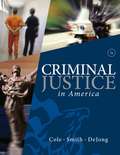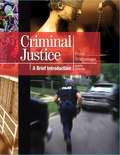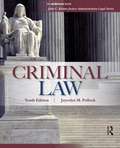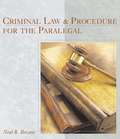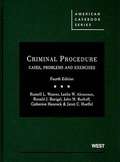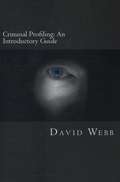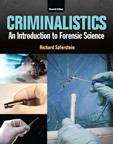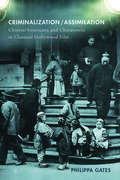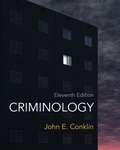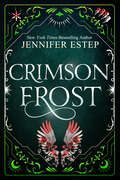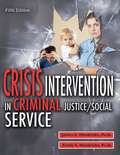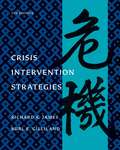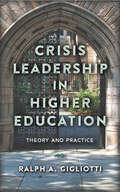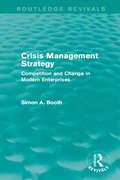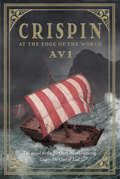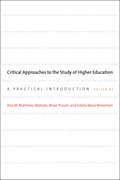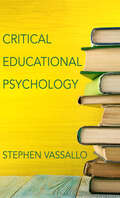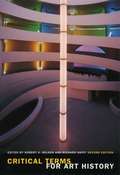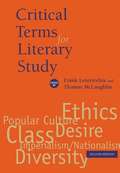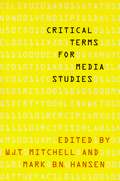- Table View
- List View
Criminal Investigation: A Method For Reconstructing the Past (Seventh Edition)
by James W. Osterburg Richard H. WardThis text presents the fundamentals of criminal investigation and provides a sound method for reconstructing a past event (i. e. , a crime), based on three major sources of information -- people, records, and physical evidence. Its tried-and-true system for conducting an investigation is updated with the latest techniques available, teaching the reader new ways of obtaining information from people, including mining the social media outlets now used by a broad spectrum of the public; how to navigate the labyrinth of records and files currently available online; and fresh ways of gathering, identifying, and analyzing physical evidence.
Criminal Justice
by Joel SamahaThe book covers the traditional core of the criminal justice system (police, courts, and corrections), focusing on the decision- making and evaluation of criminal justice policies and practices. The author has taken a provocative view of the CJ system to encourage critical thinking, providing a realistic look at problems as well as new programs which offer promise for the future.
Criminal Justice Today: An Introductory Text For The Twenty-first Century (Eighth Edition)
by Frank M. SchmallegerIn a substantially revised eighth edition, Criminal Justice Today continues to set the standard by which all other introductory criminal justice textbooks are measured. The hallmark features that have made Criminal Justice Today the most widely read college criminal justice textbook form the core of this new edition. They include: A thematic approach that contrasts the justice system's twin goals of ensuring public order and safety while guaranteeing individual rights. the book's theme, present since the first edition, is more relevant today and continues to significantly influence the direction of American society. Timely content, including current issues such as efforts to enhance homeland security, concerns about restrictions on individual freedoms in the face of terrorist threats, corporate crime, identity theft, high-technology crime, and special issues such as policing an ever-changing multicultural society. A futures orientation, including a special chapter on the future of criminal justice that points the way to and helps students appreciate the unchanging foundation upon which American criminal justice rests. Accessible technology, including easy-to-use digital tools that make it simple to stay abreast of the latest news, research reports, and government-sponsored studies of relevance to the study of criminal justice. The eighth edition also brings exciting new features to Criminal Justice Today. Among them are: Expanded police coverage, including an entirely new chapter on police organization and management. The criminal justice system's response to terrorism, including broad coverage of homeland security issues, the impact of domestic and international terrorism on criminal justice practices and procedures, individual rights in the face of enhanced security; and terrorism prevention, response, and control. Detailed coverage of corporate crime, including possible criminal activities of companies such as Enron, WorldCom, Adelphia, Vivendi Universal, Kmart, Global Crossing, Tyco International, and London-based auction house Sotheby's. Crime mapping, predictive, and enforcement technologies, including CompStat and CopLink software, wearable augmented reality devices, and biometrics. Expanded coverage of crime scene investigative strategies and techniques, with special graphics provided by the Massachusetts State Police.
Criminal Justice Today: An Introductory Text for the 21st Century (12th Edition)
by Frank J. Schmalleger"Criminal Justice Today," 12/e, continues to lead as the gold-standard for criminal justice texts. Best-selling, student- and instructor-preferred, and time-tested--Schmalleger is the most current and popular text in the market. The text guides criminal justice students in the struggle to find a satisfying balance between freedom and security, and focuses on the crime picture in America and on the three traditional elements of the criminal justice system: police, courts, and corrections.
Criminal Justice Today: An Introductory Text for the 21st Century (13th Edition)
by Frank J. SchmallegerOnce again, Schmalleger is the most current and popular text on the market and continues to lead as the gold-standard among criminal justice texts today! Criminal Justice Today: An Introductory Text for the 21st Century, 13e continues to lead as the gold-standard for criminal justice texts. Best-selling, student- and instructor-preferred, and time-tested-Schmalleger is the most current and popular text on the market. This textbook guides criminal justice students in the struggle to find a satisfying balance between freedom and security. True to its origins, the thirteenth edition focuses on the crime picture in America and on the three traditional elements of the criminal justice system: police, courts, and corrections. This edition continues to question the viability of our freedoms in a world that has grown increasingly more dangerous. Students are asked to evaluate the strengths and weaknesses of the American justice system as it struggles to adapt to an increasingly multicultural society and to a society in which the rights of a few can threaten the safety of many.
Criminal Justice in America (7th Edition)
by George F. Cole Christopher E. Smith Christina DejongThe book is designed to provide thorough introduction and comprehensive coverage to the dynamics of the American criminal justice system and illuminates contemporary issues and problems.
Criminal Justice: A Brief Introduction (9th Edition)
by Frank J. SchmallegerThe first and BEST-SELLING brief introduction to criminal justice text, Criminal Justice: A Brief Introduction 9e offers instructors and students a trusted, authoritative and impeccably researched introduction to police, courts, and corrections. Designed with a new visual approach, this edition integrates graphic art with the important concepts and ideas of criminal justice. Its unifying theme, its unmatched timeliness and its coverage of trends and technology makes this text THE standard by which all other brief texts are judged.
Criminal Law (Tenth Edition)
by Joycelyn M. PollockThe book combines the best features of a traditional law casebook with those of a textbook that helps students learn how to identify the issues and holdings from court decisions.
Criminal Law and Procedure for the Paralegal
by Neal R. BevansDelving into one of the most fascinating areas of legal practice, this book shows the real world of prosecutors, defense attorneys and paralegals in criminal law. The author brings the study of criminal law alive. Actual examples of criminal cases are investigated and explained, defenses are explored, and appellate processes are examined.
Criminal Procedure: Cases, Problems and Exercises (4th edition)
by Russell L. Weaver Leslie W. AbramsonThe fourth edition contains thought-provoking problems, and is designed to encourage classroom discussion, and help students effectively learn criminal procedure principles. Ideally suited for a one-semester course, this casebook contains all the essential decisions without being overwritten or so massive as to be unwieldy. in addition, the new edition is completely up-to-date containing the latest decisions from the United States Supreme Court, as well as problems based on important lower court decisions. Criminal Procedure: Cases, Problems and Exercises is unique because the authors actively seek to place students in situations that they are likely to encounter in practice, and asks students to think about how they might handle those situations (e. g. , what does a lawyer do when asked to represent a client at a lineup?). for this new edition, the authors have added a significant number of new problems. They have also added important cases from the United States Supreme Court's recent terms. (American Casebooks)
Criminal Profiling: An Introductory Guide
by David WebbInterested in Criminal Profiling? Designed to let you dive straight into this fascinating topic, Criminal Profiling: An Introductory Guide is based on a series of classes from an undergraduate program in forensic psychology. The guide provides clear and concise information on central issues such as the origins of criminal profiling, FBI profiling methodology and limitations; and whether becoming a profiler is a realistic career path. If you are interested in criminal profiling and would like to learn more, Criminal Profiling: An Introductory Guide is the perfect place to start.
Criminalistics: An Introduction to Forensic Science
by Richard SafersteinThis best-selling text, written for the non-scientist, is appropriate for a wide variety of students, including criminal justice, law enforcement, law, and more! Criminalistics: An Introduction to Forensic Science, 11e, strives to make the technology of the modern crime laboratory clear and comprehensible to the non-scientist. The nature of physical evidence is defined, and the limitations that technology and current knowledge impose on its individualization and characterization are examined. By combining case stories with applicable technology, Criminalistics endeavors to capture the pulse and fervor of forensic science investigations. A major portion of the text centers on discussions of the common items of physical evidence encountered at crime scenes. These chapters include descriptions of forensic analysis, as well as updated techniques for the proper collection and preservation of evidence at crime scenes. Particular attention is paid to the meaning and role of probability in interpreting the evidential significance of scientifically evaluated evidence.
Criminalization/Assimilation: Chinese/Americans and Chinatowns in Classical Hollywood Film
by Philippa GatesCriminalization/Assimilation traces how Classical Hollywood films constructed America’s image of Chinese Americans from their criminalization as unwanted immigrants to their eventual acceptance when assimilated citizens, exploiting both America’s yellow peril fears about Chinese immigration and its fascination with Chinatowns. Philippa Gates examines Hollywood’s responses to social issues in Chinatown communities, primarily immigration, racism, drug trafficking, and prostitution, as well as the impact of industry factors including the Production Code and star system on the treatment of those subjects. Looking at over 200 films, Gates reveals the variety of racial representations within American film in the first half of the twentieth century and brings to light not only lost and forgotten films but also the contributions of Asian American actors whose presence onscreen offered important alternatives to Hollywood’s yellowface fabrications of Chinese identity and a resistance to Hollywood’s Orientalist narratives.
Criminology (Eleventh Edition)
by John E. ConklinThe eleventh edition of Criminology is a lively introduction to the study of crime. As opposed to the "crime-of-the-week" approach common to many other texts, Conklin introduces students to critical issues in the field, such as the way people learn to commit crime, the development of criminal careers, and the organization of criminal behavior. The text is illustrated with copious boxed selections, easy-to-interpret tables and graphs, and dozens of compelling boxed features. While thoroughly researched and authoritative, the text is accessible to students and well-suited for one-semester courses.
Crimson Frost (The Mythos Academy #4)
by Jennifer EstepHigh school gets even harder when there&’s an evil god on the loose in the New York Times bestselling author&’s YA urban fantasy novel.My name is Gwen Frost, and I go to Mythos Academy, a school of myths, magic and warrior whiz kids. And now there&’s also Loki, the evil god I helped set free against my will. On the bright side, I finally got a date with Logan Quinn, the hottest—and deadliest—Spartan at Mythos. But I should have known it was destined to end in disaster. If we'd gotten into a swordfight, or been ambushed by Reapers, I'd have been more prepared. I definitely didn&’t expect to get arrested mid-sip at the local coffee hangout. I'm accused of purposely helping the Reapers free Loki—and the person leading the charge against me is Linus Quinn, Logan's dad. Now pretty much everyone at school thinks I'm guilty. If I'm going to get out of this mess alive, I'll have to do it myself.
Crisis Intervention In Criminal Justice/Social Service (Fifth Edition)
by James E. Hendricks Cindy S. HendricksThis expanded new edition continues to demonstrate and provide theoretical, analytical, and practical knowledge for first responders. Face-to-face interaction with the client/victim is part of the comprehensive approach advocated by the book, which requires interveners to assess the nature of a crisis and the condition of the victim in order to determine the appropriate course of action. The comprehensive balance of theory and practice presented in this book should enable the intervener in coupling his/her general knowledge of human psychology and emotional crisis with the specific and novel characteristics of various crisis situations. The text represents the work of national scholars who have expertise in criminal justice and social service issues. Their chapters focus on a Historical and Theoretical Overview, Ethics in Crisis Intervention Practice, Intimate Partner Violence, Police Response to Domestic Violence, Children in Crisis, Elder Mistreatment, Suicide, Crisis of Rape and Survivor Intervention, Death Notification and the Theory and Practice of Delivering Bad News, Terrorism and Crisis Intervention, and Mass Casualty Crisis Response and Communication. Helpful appendices in each chapter provide additional internet resources, as well as a complete Model Law Enforcement Code of Ethics and Social Work Code of Ethics. This new edition retains important information while providing current case studies such as the "Miracle on the Hudson River" crash, the mass shootings at Virginia Tech, the Boston Marathon bombing, and the Yarnell Hill fire in Arizona. This exceptional book is designed for firefighters, police officers, community service officers, correctional workers, emergency medical workers, probation/parole officers, protective service workers, psychological counselors, social workers, and victim assistance workers among others.
Crisis Intervention Strategies 7th Edition
by Richard K. James Burl E. GillilandThis authoritative, best-selling text presents the latest skills and techniques for handling real crisis situations. The authors' six-step model clearly illustrates and elucidates the process of dealing with people in crisis: Defining the Problem, Ensuring Client Safety, Providing Support, Examining Alternatives, Making Plans, and Obtaining Commitment. Using this model, the authors then build specific strategies for handling a myriad of different crisis situations, accompanied in many cases with the dialogue that a practitioner might use when working with the individual in crisis.
Crisis Leadership in Higher Education: Theory and Practice
by Ralph A GigliottiThere was a time when crises on college and university campuses were relatively rare. Much has changed, and it has changed quite rapidly. Rather than being isolated incidents requiring the sole attention of presidents, chancellors, or communication professionals, the proliferation of crises across campuses means that crisis leadership has now become fundamental to the work of university personnel across levels, disciplines, and institutions. Drawing upon the findings of forty interviews with senior leaders from ten major research universities across the United States and a content analysis of over one thousand articles from a variety of news outlets, Crisis Leadership in Higher Education presents a theory-informed framework for academic and administrative leaders who must navigate the institutional and environmental crises that are most germane to institutions of higher education. The perspectives offered in this book remind us that it is in the chaos and uncertainty of crisis that leadership becomes most visible and most critical.
Crisis Management Strategy: Competition and Change in Modern Enterprises (Routledge Revivals)
by Simon A. BoothCrisis Management Strategy, first published in 1993, is an excellent introduction to the theory and practice of crisis management in modern enterprises. Simon Booth examines the conventional approaches followed by many firms in the face of change and crisis. He warns of the dangers of theories which oversimplify the causes of crisis and their possible solutions, and which overlook the individual nature of each firm and its environment. Instead, a dynamic new vision of crisis management is offered, which takes into account different kinds of crisis demanding diverse solutions. The key role of leadership is also evaluated in relation to both internally and externally generated crises. Drawing on case studies of leading firms facing crisis solutions in a variety of environments, this truly international volume will provide valuable insight into the experience of crisis, risk and uncertainty. This title will be of interest to students of business.
Crispin: At the Edge of the World (Crispin)
by AviIn this riveting sequel to the Newbery-Award winning Crispin: The Cross of Lead--the second book in a planned trilogy--Avi explores themes of war, religion, and family as he continues the adventures of Crispin and Bear.The more I came to know of the world, the more I knew I knew it not.He was a nameless orphan, marked for death by his masters for an unknown crime. Discovering his name- Crispin-only intensified the mystery. Then Crispin met Bear, who helped him learn the secret of his full identity. And in Bear-the enormous, red-bearded juggler, sometime spy, and everyday philosopher-Crispin also found a new father and a new world.Now Crispin and Bear have set off to live their lives as free men. But they don't get far before their past catches up with them: Bear is being pursued by members of the secret brotherhood who believe he is an informer. When Bear is badly wounded, it is up to Crispin to make decisions about their future-where to go, whom to trust. Along the way they become entangled with an extraordinary range of people, each of whom affects Crispin and Bear's journey in unexpected ways. To find freedom and safety, they may have to travel to the edge of the world-even if it means confronting death itself.
Critical Approaches to the Study of Higher Education: A Practical Introduction
by Ana M. Martínez-Alemán, Brian Pusser, and Estela Mara BensimonAn essential guide to incorporating critical research into higher education scholarship.Winner of the Outstanding Publication Award of the Post-secondary Education Division of the American Educational Research AssociationCritical theory has much to teach us about higher education. By linking critical models, methods, and research tools with an advocacy-driven vision of the central challenges facing postsecondary researchers and staff, Critical Approaches to the Study of Higher Education makes a significant—and long overdue—contribution to the development of the field. The contributors argue that, far from being overly abstract, critical tools and methods are central to contemporary scholarship and can have practical policy implications when brought to the study of higher education. They argue that critical research design and critical theories help scholars see beyond the normative models and frameworks that have long limited our understanding of students, faculty, institutions, the organization and governance of higher education, and the policies that shape the postsecondary arena. A rigorous and invaluable guide for researchers seeking innovative approaches to higher education and the morass of traditionally functionalist, rational, and neoliberal thinking that mars the field, this book is also essential for instructors who wish to incorporate the lessons of critical scholarship into their course development, curriculum, and pedagogy.
Critical Educational Psychology: An Application Of Critical Educational Psychology (Educational Psychology Ser. #15)
by Stephen VassalloIntroducing students and scholars to the emerging field of critical educational psychology.The field of critical studies recognizes that all knowledge is deeply embedded in ideological, cultural, political, and historical contexts. Although this approach is commonly applied in other subfields of psychology, educational psychology—which is the study of human learning, thinking, and behavior in formal and informal educational contexts—has resisted a comprehensive critical appraisal. In Critical Educational Psychology, Stephen Vassallo seeks to correct this deficit by demonstrating how the psychology of learning is neither neutral nor value-free but rather bound by a host of contextual issues and assumptions. Vassallo invites teachers and teacher educators, educational researchers, and educational psychologists to think broadly about the implications that their use of psychology has on the teaching and learning process. He applies a wide variety of interdisciplinary approaches to examine the psychology of learning, cognitive development, motivation, creativity, discipline, and attention. Drawing on multiple perspectives within psychology and critical theory, he reveals that contemporary educational psychology is entangled in and underpinned by specific political, ideological, historical, and cultural contexts.A valuable resource for anyone who relies on psychology to interact with, assess, and deliberate over others, especially school-aged children, Critical Educational Psychology resists neatly packaged theories, models, and perspectives that are intended to bring some basis and certainty to pedagogical decision-making. This book will enhance teachers’ ethical decision-making and start important new conversations about power and opportunity.
Critical Terms for Art History (2nd edition)
by Robert S. Nelson Richard Shiff"Art" has always been contested terrain, whether the object in question is a medieval tapestry or Duchamp's Fountain.
Critical Terms for Literary Study (2nd edition)
by Frank Lentricchia Thomas MclaughlinAn expanded introduction to the work of literary theory covering the concepts that shape the way we read, with 28 essays written by a plethora of distinguished scholars.
Critical Terms for Media Studies
by W. J. T. Mitchell Mark HansenCommunications, philosophy, film and video, digital culture: media studies straddles an astounding array of fields and disciplines and produces a vocabulary that is in equal parts rigorous and intuitive. Critical Terms for Media Studiesdefines, and at times, redefines, what this new and hybrid area aims to do, illuminating the key concepts behind its liveliest debates and most dynamic topics. Part of a larger conversation that engages culture, technology, and politics, this exciting collection of essays explores our most critical language for dealing with the qualities and modes of contemporary media. Edited by two outstanding scholars in the field, W.J.T. Mitchell and Mark B.N. Hansen, the volume features works by a team of distinguished contributors.
